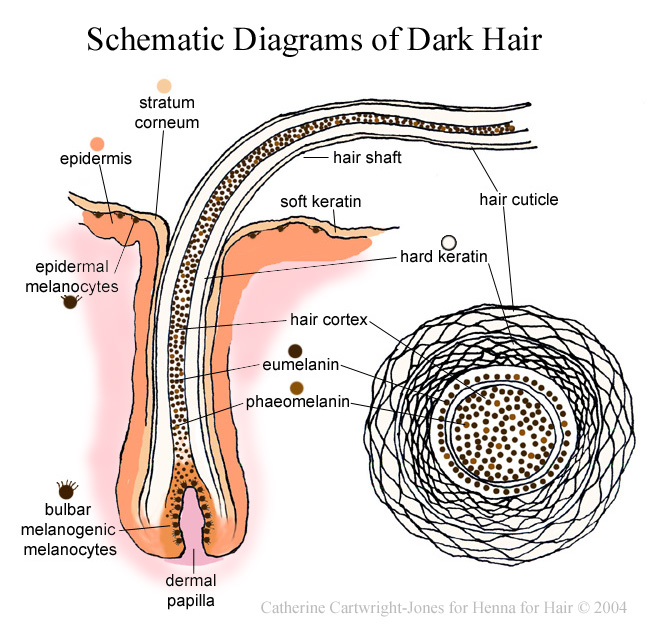How does hair get its
color?
How does it turn gray?

How does hair get its
color?
How does it turn gray?

|
How does
hair turn gray? The melanocytes in hair stop producing melanins!
Everybody has melanocytes, in their skin and in their hair. Some people have very active melanocytes: dark skinned people have highly productive epidermal melanocytes. People who have highly active bulbar melanogenic melanocytes have highly pigmented hair. An albino, gray haired person, or someone with alopecia may inactive melanocytes. Bulbar melanocyte activity may be determined by heredity or disease. Worry does not affect bulbar melanocytes: your annoying children or employees do not actually cause you to get gray hair! Creatures who have striped hairs have melanocytes that alternate melanocyte productivity and inactivity. Some creatures have seasonal melanocyte activity: these may have white coats in winter season and dark coats in summer season. Bulbar melanogenetic cells produce two kinds of melanocytes: eumelanin and phaeomelanin. Eumalanin is a very dark melanin granule, and predominates in very dark hair. Phaeomelanin is a lighter melanin and predominates in blonde or red hair. These melanins are present in different combinations in hair according to heredity and age. Infants often have higher proportions of phaeomelanins, and older people often have higher proportions of eumelanins. Simply stated: it's not unusual for a blonde child to have darker hair as an adult. Different melanin levels are dispersed differently across the mosaic of human body hair. In adults, eumelanins are present in higher quantities in adult and pubic hair than cranial hair. Adult males may have higher phaeomelanins in their mustaches and beards than on their cranial hair. Simply stated: humans grow hair here and there in clumps while other mammals grow it in an attractive overall coat, and human head hair is frequently paler than the other bits. Most people's individual hairs have some variation in eumalanin and phaeomelanin: most people have considerable variation among their individual hairs. That's one of the reasons why synthetic dyes tend to look "fake". Synthetic dyes tend to make every hair the same color, and hair naturally grows a variety of colors within a set genetically determined range. Your natural hair color is a combination of your eumelanins and phaeomelanins. Everybody's a bit different there., and everybody's hair will change throughout their life, and over their bodies. When you henna your hair, the resultant color is a combination of henna, and your natural hair color. Henna stains the translucent keratin surrounding the colors in the hair cortex. Because the henna dye stains the outer layers of the hair shaft, hennaed hair shimmers red in the sunlight. References: Graying: gerontobiology of the hair follicle pigmentary unit D.J. Tobin, R. Paus Department of Biomedical Sciences, University of Bradford, Bradford, West Yorkshire BD7 1DP, UK Department of Dermatology, University Hospital Eppendorf, Hamburg, Germany Experimental Gerontology 36 (2001) 29-54  Go to: How Does Hair Turn Gray?  Go to: How Does Hair Turn White? |